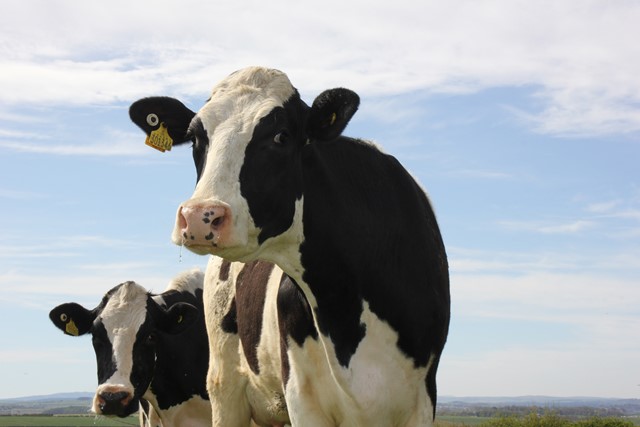Common Causes Of Milk Fever In Dairy Cattle
20 June 2023Milk fever is one of the most common mineral-related metabolic disorders affecting dairy cows at parturition as a result of low plasma calcium. Economically, milk fever is an important disease, a clinical disease has an estimated cost of £200–250 (including cost of treatment, increased risks of other disease, potential milk yield loss, culling, and reduced fertility). There are several predisposing factors which contribute to the risk of hypocalcaemia, commonly known as milk fever. Research suggests that breed, age, body condition and mineral provision are highly influential.
Milk Fever by The Numbers
Some breeds are more prone to milk fever, in particular Jersey cows. Two pieces of research have shown that Jersey cows are 2.25 times more likely to suffer from milk fever than Holsteins, and that the incidence of milk fever was 4.82% in Holsteins and 14.78% in Jerseys. Several factors cause the variation in incidence between the two breeds. Firstly, Holstein cattle have a greater number of intestinal vitamin D receptors compared to Jersey cows (142 v. 95 fmol/mg protein, respectively). Lower amounts of intestinal vitamin D receptors may reduce the amount of calcium that can be absorbed from the intestines into the blood stream. Moreover, the level of milk production in relation to body size could be influential. Jersey cows produce more milk per kilogram of bodyweight compared to Holsteins (average BW = 680 kg; average milk production = 35 kg/day vs. average BW = 454 kg; average milk production = 31.7 kg/day – figures based on US research (Capper and Cady, 2012).
Milk Fever Risk Increases with Age
Regardless of the breed, the incidence of milk fever increases with age. Milk fever is very rare in the first lactation; however, each successive lactation increases the risk by 9%, and the incidence dramatically increases beyond the third lactation (Figure 1). The general consensus of why the incidence of milk fever increases with age is due to a combination of reasons. Firstly, milk production increases with age, which therefore increases the demand for calcium for milk production. Ageing also causes a decline in the ability to mobilise calcium from bone stores and reduced active transport of calcium within the body. Consequently, these impairments mean that older cows are less able to respond to the increasing demand for calcium at the start of lactation.

Good Body Condition Scores Reduce Milk Fever
Ensuring the correct body condition score (BCS) at calving is important in preventing milk fever, as cows with a BCS of over 4 are 3.3 times more susceptible to milk fever than cows that are at the target BCS for calving of 2.5-3. The increased prevalence of milk fever in ‘fat’ cows is due to reduced dry matter intake, which decreases dietary intake of magnesium that is vital for blood calcium regulation.
Keep An Eye on Your Cattle's Mineral Diet
The prepartum diet mineral composition influences the risk of milk fever, particularly calcium, magnesium, and phosphorus. Diets that are too high in calcium (>50g/day) can cause the calcium regulation system in the body to become unresponsive, which means that the mobilisation of calcium from body reserves is impaired. This is often the case with dry cow diets containing high levels of grass silage which can have a high calcium content. At parturition, calcium requirements increase by approximately three-fold (50g/day), and there will be an extended period where the calcium pool within the cow (approximately 12g) is unable to satisfy the calcium requirement, resulting in milk fever.
Magnesium influences the production of parathyroid hormone, which is essential in calcium regulation, as such, magnesium deficiencies have been known to cause milk fever in between 80-90% of herds. Therefore, it is advised that pre-calving diets contain a minimum of 0.4% magnesium in the dry matter (DM). Magnesium absorption can also be impaired by high potassium levels in silage, from high slurry applications or inorganic fertiliser. Therefore, it is good practice to make silage specifically for dry cows that has come from land that has had no slurry or potassium fertiliser applied. Silage mineral analysis and soil sampling can help determine potassium status and the best nutritional approach for minimising milk fever risk in the future.
The calcium regulatory mechanism is also impaired by high levels of phosphorus; therefore, it is suggested that intakes should not exceed 0.35% DM, which can difficult to achieve on a heavily grass silage-based diet. To help manage the milk fever risk, if the low calcium approach is not effective at keeping the incidence of milk fever at the target of less than 5%, a DCAB (dietary cation-anion balance) diet or use of a calcium binder could be considered.
Key Steps to Protect Your Cattle From Milk Fever
If you’re finding that you have a high prevalence of milk fever in your herd, it’s important to consider the following three things.
- Consider the age of your herd. Older cattle are much more vulnerable to milk fever. Particularly above the age of four.
- Be vigilant about body condition scoring your cattle. If the BCS rises above four, then the risk is significantly higher, and you should take preventative measures.
- Closely monitor the diets and mineral intake of your herd. Calcium, magnesium, and phosphorus all play a part when it comes to preventing milk fever.
References available upon request.
olivia.ward@sac.co.uk; 01539 769059
Sign up to the FAS newsletter
Receive updates on news, events and publications from Scotland’s Farm Advisory Service

